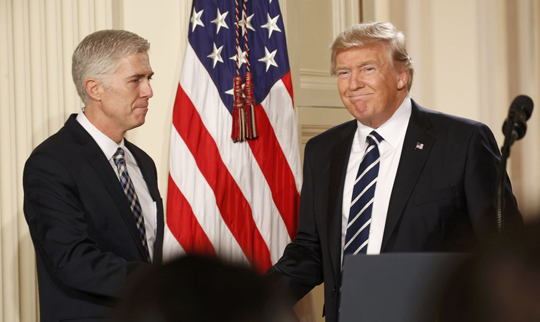Washington, Feb 1: US President Donald Trump has nominated young federal appeals court judge Neil Gorsuch for the high-profile job on the Supreme Court, elevating a jurist who could cement the court's conservative bent and help shape the American legal establishment for decades, including on divisive issues such as gun control and religious rights.

Gorsuch, 49, is the youngest Supreme Court nominee in a quarter century and is Trump's pick to fill a vacancy caused by the death of conservative Justice Antonin Scalia nearly a year ago.
Gorsuch's nomination underscores the fast-rising conservative's potential to shape major decisions for decades to come on major divisive issues such as abortion, gun control, the death penalty and religious rights.
"I am proud to announce the nomination of Judge Neil Gorsuch for Justice of the Supreme Court," Trump said in a televised prime-time event from the East Room of the White House.
"Judge Gorsuch has outstanding legal skills, a brilliant mind, tremendous discipline and has earned bipartisan support," Trump said adding, "It is an extraordinary resume — as good as it gets."
Born and raised in Colorado, Gorsuch attended Columbia University and Harvard Law School and after graduating with honours, he received his doctorate from the Oxford University as a Marshall Scholar.
Gorsuch is seen as an "originalist" who believes in the American Constitution's original intent and meaning.
"Judge Gorsuch has a superb intellect, an unparallelled legal education, and a commitment to interpreting the Constitution according to its text. He will make an incredible Justice as soon as the Senate confirms him," Trump said.
Making his first nomination to the Supreme Court, Trump also said that he was fulfilling his promise to select someone who loves the Constitution and respects laws and will interpret them as written.
In 2006, then President George W Bush nominated Gorsuch for the US Court of Appeals for the Tenth Circuit, and he was confirmed by voice vote without objection.
"I am honoured and humbled to receive this nomination. I look forward to meeting with Senators over the coming weeks as we begin this process," Gorsuch said.
Outlining his legal ideas, Gorsuch said: "It is the rule of judges to apply, not alter, the work of the people's representatives. A judge who likes every outcome he reaches is very likely a bad judge."
He also praised Justice Scalia as "a lion of the law."
Trump said he hoped both Democrats and Republicans can come together for once for the good of the country. But some Democrats have vowed to mount a vigorous challenge to nearly any nominee to what they view as the court's "stolen seat."
"This may be the most transparent judicial selection process in history," Trump said, adding "the qualifications of Judge Gorsuch are beyond dispute."
As a young man, Gorsuch delivered papers and worked as a front desk clerk at a Howard Johnson to make extra money. Now, he enjoys fishing, hiking and skiing. He and his wife care for animals, including a horse, in the small barn at their home.
The silver-haired jurist is known for writing incisive rulings, advocacy for court review of government regulations and defence of religious freedom.
If confirmed, Gorsuch's appointment could have a major impact on abortion, gender rights and gun control issues. Although Republicans hold 52 seats in the Senate, they need 60 to confirm a nominee.
"I pledge that if I am confirmed I will do all my powers permit to be a faithful servant of the Constitution and laws of this great country," Gorsuch said.
He said the Supreme Court's work is vital to protect the people's liberties under law and to the "continuity of our Constitution, the greatest charter of human liberty the world has ever known."
House Speaker Paul Ryan said in Gorsuch, Trump fulfilled his pledge to nominate a judge who has demonstrated loyalty to the Constitution. "He is a phenomenal nominee for the Supreme Court."
House Majority Leader Kevin McCarthy said Congress and the American people don't want a liberal Supreme Court justice or a conservative Supreme Court justice. "We want a justice who will decide cases based on the law and the Constitution as they are written. Neil Gorsuch appears to fit that mold."
The Democrats, however, voiced their opposition.
"Given his record, I have very serious doubts about Judge Gorsuch's ability to meet this standard. Judge Gorsuch has repeatedly sided with corporations over working people, demonstrated a hostility toward women's rights, and most troubling, hewed to an ideological approach to jurisprudence that makes me sceptical that he can be a strong, independent Justice on the Court," said Senate minority leader Charles Schumer.
"Make no mistake, Senate Democrats will not simply allow but require an exhaustive, robust, and comprehensive debate on Judge Gorsuch's fitness to be a Supreme Court Justice," he said, adding that the Senate must insist upon 60-votes for any Supreme Court nominee, a bar that was met by each of President Barack Obama's nominees.
Democratic Senator Patrick Leahy said he had hoped that Trump would work in a bipartisan way to pick a mainstream nominee like Merrick Garland and bring the country together.
"Instead, he outsourced this process to far-right interest groups. This is no way to treat a co-equal branch of government, or to protect the independence of our federal judiciary," he said.
National Abortion Federation in a statement expressed its disappointment. "We need a Supreme Court justice who will honour established precedent, including the constitutional right to privacy and Roe v Wade. That Justice is not Neil Gorsuch," said its president and CEO Vicki Saporta.





Comments
good
Add new comment